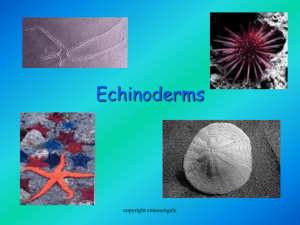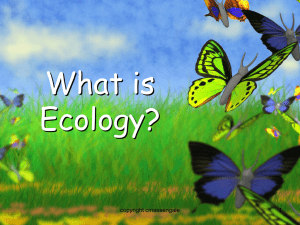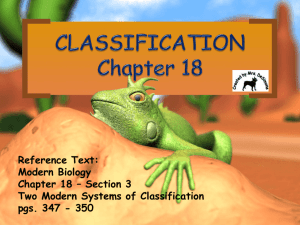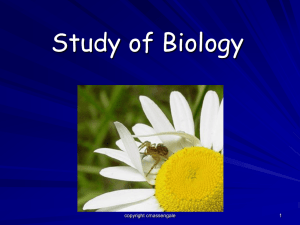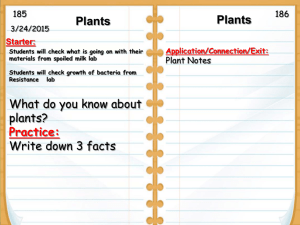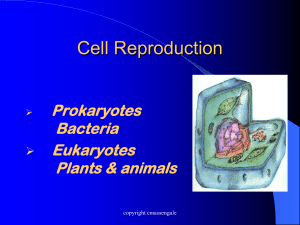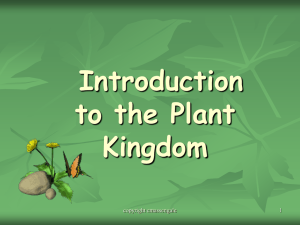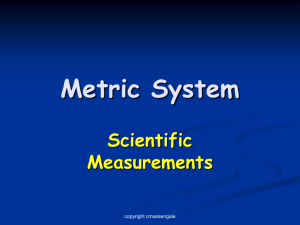Classification Powerpoint
advertisement
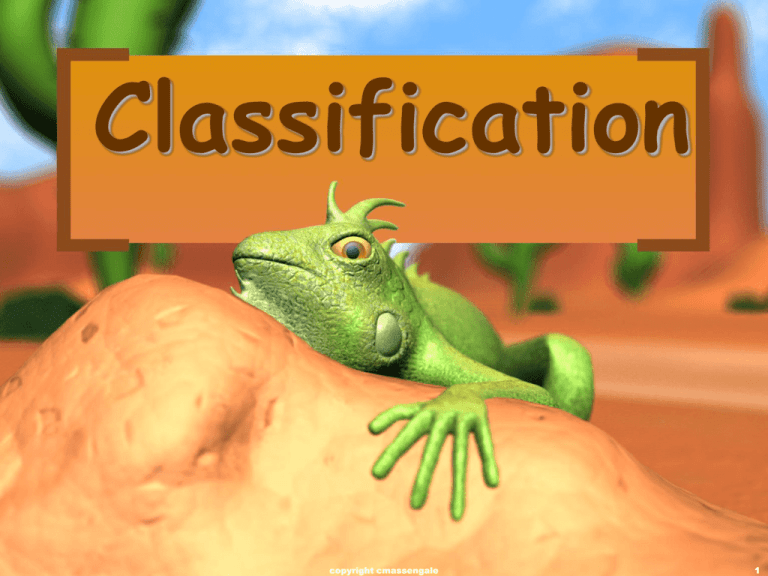
Classification copyright cmassengale 1 Species of Organisms •There are 13 billion known species of organisms •This is only 5% of all organisms that ever lived!!!!! •New organisms are still being found and identified copyright cmassengale 2 What is Classification? Classification is the arrangement of organisms into orderly groups based on their similarities Classification is also known as taxonomy Taxonomists are scientists that identify & name organisms copyright cmassengale 3 Benefits of Classifying •organisms Accurately & uniformly names •starfish Prevents misnomers such as & jellyfish that aren't really fish Uses same language (Latin or some Greek) for all names • Sea”horse”?? copyright cmassengale 4 Confusion in Using Different Languages for Names copyright cmassengale 5 Latin Names are Understood by all Taxonomists copyright cmassengale 6 Early Taxonomists •2000 years ago, Aristotle was the first taxonomist Aristotle divided organisms into plants & animals He subdivided them by their habitat ---land, sea, or air dwellers • • copyright cmassengale 7 Early Taxonomists •John Ray, a botanist, was the first to use Latin for naming His names were very long descriptions telling everything about the plant • copyright cmassengale 8 Carolus Linnaeus 1707 – 1778 • 18th century taxonomist • Classified • organisms by their structure Developed naming system still used today copyright cmassengale 9 Carolus Linnaeus •Called the “Father of Taxonomy” •Developed the modern system of naming known as binomial nomenclature Two-word name (Genus & species) • copyright cmassengale 10 Standardized Naming •Binomial nomenclature used •Genus species •Latin or Greek •Italicized in print •Capitalize genus, but NOT species •Underline when Turdus migratorius writing American Robin copyright cmassengale 11 Binomial Nomenclature Which TWO are more closely related? copyright cmassengale 12 Rules for Naming Organisms • The International Code for • • Binomial Nomenclature contains the rules for naming organisms All names must be approved by International Naming Congresses (International Zoological Congress) This prevents duplicated names copyright cmassengale 13 Classification Groups • Taxon ( taxa-plural) is a • • category into which related organisms are placed There is a hierarchy of groups (taxa) from broadest to most specific Domain, Kingdom, Phylum, Class, Order, Family, Genus, species copyright cmassengale 14 Hierarchy-Taxonomic Groups BROADEST TAXON Domain Kingdom Phylum (Division – used for plants) Class Order Family Genus Species Most Specific copyright cmassengale 15 Delightful King Phil Came Over For Good Soup! copyright cmassengale 16 copyright cmassengale 17 Domains • Broadest, most inclusive taxon • Three domains • Archaea and Bacteria are • unicellular prokaryotes (no nucleus or membrane-bound organelles) Eukarya are more complex and have a nucleus and membranebound organelles copyright cmassengale 18 ARCHAEA • Kingdom - ARCHAEBACTERIA • Cell type-prokaryote-lacks a nucleus • Live in HARSH environments • Found in: –Sewage Treatment Plants (Methanogens) –Thermal or Volcanic Vents (Thermophiles) –Hot Springs or Geysers that are acid –Very salty water (Dead Sea; Great Salt Lake) - Halophiles copyright cmassengale 19 ARCHAEAN • Cell walls without peptidoglycan • Unicellular • Autotroph or heterotroph copyright cmassengale 20 BACTERIA • Kingdom - EUBACTERIA • Some may cause DISEASE • Found in ALL HABITATS except harsh ones • Important decomposers for environment • Commercially important in making cottage cheese, yogurt, buttermilk, etc. copyright cmassengale 21 Live in the intestines of animals • Prokaryote-lacks a nucleus • Cell walls with peptydoglycanpolymer consisting of sugars and amino acids that forms a mesh-like layer outside the plasma membrane • Unicellular • Autotroph or heterotroph copyright cmassengale 22 copyright cmassengale 23 Domain Eukarya is Divided into Kingdoms •Protista (protozoans, algae…) •Fungi (mushrooms, yeasts …) •Plantae (multicellular plants) •Animalia (multicellular animals) copyright cmassengale 24 copyright cmassengale 25 Protista •Most are unicellular •Some are multicellular •Some colonial •Some are autotrophic, some heterotrophic copyright cmassengale 26 Protista •Eukaryote •Some cell walls of cellulose •Some chloroplasts •Amoebas and Slime molds copyright cmassengale 27 copyright cmassengale 28 Fungi • Multicellular, except yeast unicellular Absorptive heterotrophs • (digest food outside their body & then absorb it) • Cell walls made of chitin copyright cmassengale 29 Fungi • Eukaryote-has a nucleus • Examples: Mushrooms and yeasts copyright cmassengale 30 Plantae •Multicellular •Some green algae are unicellular •chloroplasts •Autotrophic •Absorb sunlight to make glucose – Photosynthesisautotroph copyright cmassengale 31 Plantae •Cell walls made of cellulose •Eukaryote •Mosses, ferns, flowering plants copyright cmassengale 32 • Multicellular • Ingestive • Animalia heterotrophs (consume food & digest it inside their bodies) Feed on plants or animals copyright cmassengale 33 Animalia • Eukaryote • No cell wall or chloroplasts • Sponges, worms, insects, fish, mammals copyright cmassengale 34 copyright cmassengale 35 Taxons •Most genera contain a number of similar species •The genus Homo is an exception (only contains modern humans) Classification is based on evolutionary relationships • copyright cmassengale 36 copyright cmassengale 37 Basis for Modern Taxonomy •Homologous structures (same structure, different function) Similar embryo development Molecular Similarity in DNA, RNA, or amino acid sequence of Proteins • • copyright cmassengale 38 Homologous Structures (BONES in the FORELIMBS) shows Similarities in mammals. copyright cmassengale 39 Cladogram Diagram showing how organisms are related based on shared, derived characteristics such as feathers, hair, or scales Phylogeny-study of how living things and extinct organisms are related to one another copyright cmassengale 40 Cladogram Clade-a group of species that includes a single common ancestor and all descendants of that ancestor copyright cmassengale 41 Primate Cladogram copyright cmassengale 42 Dichotomous Keying •Used to identify organisms •Characteristics given in pairs •Read both characteristics and either go to another set of characteristics OR identify the organism copyright cmassengale 43 Example of Dichotomous Key 1a 1b 2a 2b 3a 3b 4a 4b Tentacles present – Go to 2 Tentacles absent – Go to 3 Eight Tentacles – Octopus More than 8 tentacles – 3 Tentacles hang down – go to 4 Tentacles upright–Sea Anemone Balloon-shaped body–Jellyfish Body NOT balloon-shaped - 5 copyright cmassengale 44 copyright cmassengale 45
